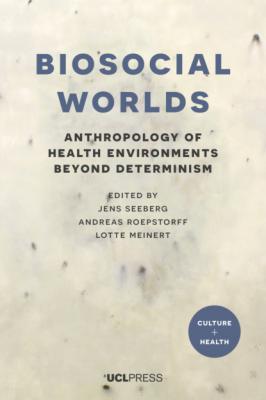Biosocial Worlds. Группа авторов
Читать онлайн.| Название | Biosocial Worlds |
|---|---|
| Автор произведения | Группа авторов |
| Жанр | Биология |
| Серия | |
| Издательство | Биология |
| Год выпуска | 0 |
| isbn | 9781787358263 |
Notes
1. https://www.benefits.va.gov/compensation/claims-special-birth_defects.asp.
2. Marasmus and kwashiorkor are two common forms of serious protein-energy malnutrition.
References
Barnes, B. and J. Dupré. 2008. Genomes and What to Make of Them. Chicago: University of Chicago Press.
Bennett, C. 2013. ‘The budget and First Nations: Opportunity lost’, iPolitics, 1 April.
Biello, D. 2015. ‘Did the Anthropocene begin in 1950 or 50,000 years ago?’, Scientific American, 2 April. Accessed 26 July 2020. https://www.scientificamerican.com/article/did-the-anthropocene-begin-in-1950-or-50-000-years-ago/.
Blackburn, E. H. and E. S. Epel. 2012. ‘Too toxic to ignore’, Nature 490: 169–71. https://doi.org/10.1038/490169a.
Boseley, S. 2016. ‘World Bank to name and shame countries that fail to prevent stunting in children’, The Guardian, 30 September. Accessed 2 July 2020. https://www.theguardian.com/global-development/2016/sep/30/world-bank-name-and-shame-countries-fail-stunted-children.
Carr, G. 2013. ‘Bearing witness: A brief history of the Indian residential schools in Canada’. In Witnesses: Art and Canada’s Indian residential schools, edited by S. Watson, K. Wallace and J. Tyner, 9–21. Vancouver: Morris and Helen Belkin Art Gallery.
Carson, R. 1962. Silent Spring. Boston: Houghton Mifflin.
Cecil, J. E., R. Tavendale, P. Watt, M. M. Hetherington and C. N. Palmer. 2008. ‘An obesity-associated FTO gene variant and increased energy intake in children’, New England Journal of Medicine 359 (24): 2558–66. https://doi.org/10.1056/NEJMoa0803839.
Chakrabarty, D. 2009. ‘The climate of history: Four theses’, Critical Inquiry 35 (2): 197–222. https://doi.org/10.1086/596640.
Cortessis, V. K., D. C. Thomas, A. J. Levine, C. V. Breton, T. M. Mack, K. D. Siegmund, R. W. Halle and P. W. Laird. 2012. ‘Environmental epigenetics: Prospects for studying epigenetic mediation of exposure–response relationships’, Human Genetics 131: 1565–89. https://doi.org/10.1007/s00439-012–1189-8.
Daschuk, J. 2013. Clearing the Plains: Disease, politics of starvation and the loss of Aboriginal life. Regina, SK: University of Regina Press.
El Akkad, O. 2016. ‘A lead weight’, The Globe and Mail, 3 May. Accessed 2 July 2020. https://www.theglobeandmail.com/news/world/flints-water-crisis-a-harbinger-of-larger-lead-problem-in-theus/article29838676/.
Farquhar, J. 1994. Knowing Practice: The clinical encounter in Chinese medicine. Boulder, CO: Westview Press.
Feil, R. and M. F. Freger. 2012. ‘Epigenetics and the environment: Emerging patterns and implications’, Nature Reviews Genetics 13: 97–109. https://doi.org/10.1038/nrg3142.
Forrester, T. E., A. V. Badaloo, M. S. Boyne, C. Osmond, D. Thompson, C. Green, C. Taylor-Bryan, A. Barnett, S. Soares-Wynter, M. A. Hanson, A. S. Beedle and P. D. Gluckman. 2012. ‘Prenatal factors contribute to the emergence of Kwashiorkor or Marasmus in severe undernutrition: Evidence for the predictive adaptation model’, PLoS One 7 (4): e35907. https://doi.org/10.1371/journal.pone.0035907.
Fowler, L. 2013. ‘Interview: Lead Wars authors Gerald Markowitz and David Rosner’, Florida Center for Investigative Reporting, 11 April. Accessed 2 July 2020. https://fcir.org/2013/04/11/interview-lead-wars-authors-gerald-markowitz-and-david-rosner/.
Friesen, J. 2013. ‘Widening education gap leaves aboriginal Canadians further behind’. The Globe and Mail, 7 October. Accessed 2 July 2020. https://www.theglobeandmail.com/news/national/education/widening-education-gap-leaves-aboriginal-canadians-further-behind/article14738527/.
Gammeltoft, T. M. 2014. Haunting Images: A cultural account of selective reproduction in Vietnam. Berkeley: University of California Press.
Gibbs, W. 2003. ‘The unseen genome: Gems among the junk’, Scientific American 289 (5): 26–33. https://doi.org/10.1038/scientificamerican1103-46.
Gilbert, S. F. 2003. ‘The reactive genome’. In Origination of Organismal Form: Beyond the gene in developmental and evolutionary biology, edited by G. B. Müller and S. A. Newman, 87–101. Cambridge, MA: MIT Press.
Gluckman, P. and M. A. Hanson. 2006. Mismatch: The timebomb of lifestyle disease. Oxford: Oxford University Press.
Grandjean, P. and P. Landrigan. 2006. ‘Developmental neurotoxicity of industrial chemicals’, The Lancet 368 (9553): 2167–78. https://doi.org/10.1016/S0140-6736(06)69665–7.
Hamzelou, J. 2016. ‘Neuroscientist sees kids suffer brain damage due to dire poverty’, New Scientist, 28 September. Accessed 5 July 2020. https://newscientist.com/article/mg23130931-200-we-thought-the-romanian-orphanages-were-bad.
Hertzman, C. 1999. ‘The biological embedding of early experience and its effects on health in adulthood’, Annals of the New York Academy of Sciences 896: 85–95. https://doi.org/10.1111/j.1749–6632.1999.tb08107.x.
Hughes, V. 2012. ‘Stress: The roots of resilience’, Nature 490 (7419): 165–7. https://doi.org/10.1038/490165a.
Jablonka, E. and M. J. Lamb. 2002. ‘The changing concept of epigenetics’, Annals of the New York Academy of Sciences 981: 82–96. https://doi.org/10.1111/j.1749–6632.2002.tb04913.x.
Jaffee, S. R. and C. W. Christian. 2014. ‘The biological embedding of child abuse and neglect: Implications for policy and practice’, Social Policy Report 28: 1–35. https://doi.org/10.1002/j.2379–3988.2014.tb00078.x.
Johansen,
